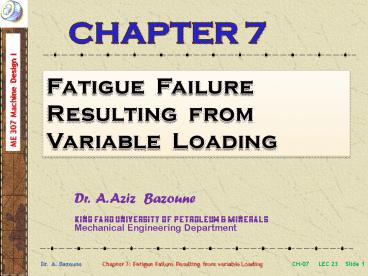CH07 LEC 23 Slide 1 - PowerPoint PPT Presentation
1 / 18
Title:
CH07 LEC 23 Slide 1
Description:
7-10 Stress Concentration Factor and Notch Sensitivity. In fatigue: Stress concentration should always be taken into account. CH-07 LEC 23 Slide 4 ... – PowerPoint PPT presentation
Number of Views:123
Avg rating:3.0/5.0
Title: CH07 LEC 23 Slide 1
1
CHAPTER 7
Fatigue Failure Resulting from Variable
Loading
Dr. A. Aziz Bazoune King Fahd University of
Petroleum Minerals Mechanical Engineering
Department
2
Lecture 23
3
7-10 Stress Concentration Factor and Notch
Sensitivity
In fatigue Stress concentration should always be
taken into account.
4
Some materials are not fully sensitive to notches
and a reduced value of Kt is used and the maximum
stress is calculated as follows
(7-29)
Kf is the fatigue stress concentration factor,
for simple loading (Ex 7.7)
or
5
(No Transcript)
6
(No Transcript)
7
- In analysis or design work
- Find first from the geometry of the part
- Specify the material
- Find
- Solve for from the following Equation
(7-31)
Figure 7-20 has its basis the Neuber equation,
which is given by
(7-32)
Where is defined as the Neuber constant and
is a material constant.
8
Equating Eqs. (7-31) and (7-32) gives the notch
sensitivity equation
(7-33)
For steel, with in kpsi, the Neuber
equation can be approximated by a third
polynomial fit of data as
(7-34)
Where is defined as the Neuber constant and
is a material constant.
9
A distinction in the configuration of the notch
is accounted for in the modified Neuber equation
(after Heywood), where the fatigue
stress-concentration factor is given as
(7-35)
Table 7-8 Heywoods Parameter for steels
where Table 7-8 gives values of for
steels for transverse holes, shoulders and
grooves.
10
Example 7-3 (Textbook)
- A steel has a minimum strength of 520 MPa and a
machined Surface. Estimate ka . - SOLUTION
- From Table 7-4, a4.51 and b-0.265
- From Eq.(7-18)
- therefore
11
Remark From this chart , it is seen that the
surface factor Ka for machined or cold drawn is
always less than 0.8.
12
Example 7-4 (Textbook)
SOLUTION
- From Eq. (7-19)
- From Table (7-5)
- From Eq. (7-19)
13
Example 7-5 (Textbook)
SOLUTION
- From Eq. (7-26)
- Interpolating from Table (7-6) gives
- From Eq. (7-8)
14
(No Transcript)
15
Example 7-6 (Textbook)
- Figure 7-20
- Equations (7-32) and (7-34)
- Equations (7-35)
SOLUTION
- From Figure A-15-9
- From Figure (7-20), for
- Sut 690 MPa and r 3 mm
- From Eq. (7-31)
See next page
16
(No Transcript)
17
(No Transcript)
18
- From Eq. (7-34)
- with Sut 690 Mpa100kpsi, and
- Substitute into Eq. (7-32) with r 3 mm
- From Table 7-8
- From Eq. (7-35)
With 2.5 lower than a) and b)































